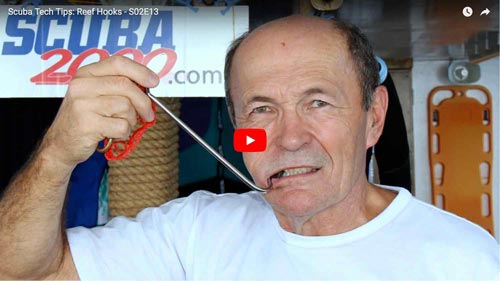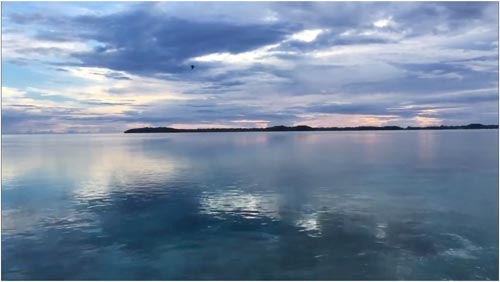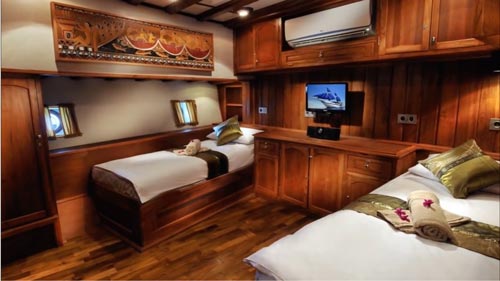The Lovely and Remote Palau Islands
The Republic of Palau
Palau offers some of the finest liveaboard diving on the planet. Palau is an island country located 8º north of the equator and 1678 kilometers (906 nautical miles) southeast of Manila. The country contains over 300 islands in an area of 466 square kilometers or 180 square miles. Koror Island is the most populous and the location of the international airport. Surrounding Palau is some of the deepest ocean in the entire world. The deep surrounding ocean teams with sharks and pelagics making it a divers wet dream. The Yap Trench between Palau and the Mariana Trench has a depth of over 8,000 meters or 27,000 feet. Palau shares maritime boundaries with the Philippines, Indonesia, and the Federated States of Micronesia.
The diving industry in Palau is thriving and popular. There are Palau liveaboard boats, yachts and day boats that can get you to the dive sites. There are a number of hotels on the islands for your stay. Some areas of Palau are completely off limits to protect the environment and to enhance fishing grounds.
A Short History
The country was settled approximately 3,000 years ago with immigrants from the Philippines and Indonesia. European explorers came along in the 16th century and eventually the islands came under control of the Spanish. After the Philippine-American War of 1899, Palau was sold to Germany. Japan gained control of the islands during and after World War I. During World War II, naval and land battles were fought with the US eventually seizing control of the islands. Evidence of those terrible battles still exist today both underwater and onshore in the shape of shipwrecks, tanks and fighting vehicles, and huge chains which closed off the harbor. After the war the islands came under the protection of the US Government but gained independence in 1994. The islanders decided not to join the Federated States of Micronesia.
The US dollar is the currency of choice and the two main languages spoken are Palauan and English. Japanese and the Filipino languages are also widely spoken and there are a number of guest workers living on the islands. The economy consists of tourism, fishing and agriculture. The population is only about 13,000 people and it feels as if everyone knows each other.
The Germans set up guano mines on the islands to extract bauxite and phosphate, and built a significant feature we divers rely on today called the German Channel. The channel was built to get product from the islands to barges. Today dive boats use it as a shortcut to the outer dive sites and as a dive site itself.
Protection of the environment is a major theme in Palau. The Government is busy attempting to establish an enforceable no shark fishing area. Tourism numbers are controlled. Green fees are collected by the government and used to protect the islands’ marine resources. Most of the community is onboard with environmental programs not just to ensure the survival of their tourism industry, but also to keep fishing stocks healthy for local people to enjoy. Deep offshore fishing buoys have been set up so locals can avoid fishing on the reefs, and illegal foreign fishing boats are dealt with harshly. Rules are in place to keep divers and dive boats from damaging reefs and there are even scientists studying how to grow marine aquarium fish for that trade. Their success will take a lot of pressure off the world’s reefs. Palau has a bright future as the Palauans have a deeply ingrained sense of the importance of the ocean and environment.
Getting There and Staying There
The international airport in Palau is in the population center of Koror Island (ROR). Palau is in the middle of nowhere and it’s not quick to get there from anywhere. Rest assured, the rewards are worth the struggle.
Manila is a short 2 ½ hour flight, but depending on the day of the week and which direction you’re flying from, you may have to fly via Guam which adds significantly to the time. United Airlines services this South Pacific route of Guam, Yap, Chuuk, Pohnpei and other remote islands. Guam is the hub of the tropical Pacific. You may fly to Guam from Hong Kong, South Korea, Japan, Taiwan, or from the US via Honolulu. When you dive Palau, it’s a good idea to include a stopover on the way to or from your home. Depending on the direction you’re coming from, Europe or the US, this could be either a sister Pacific Island or the Philippines.
Palau liveaboard dive boats leave from the harbor at Koror, it’s a scenic 30-minute drive from the airport.
There are a number of hotels in Koror to choose from, most of them pretty overpriced for what they are. But on an island of 13,000 people this is to be expected. Prices begin at $140 US per night and go up from there. You may fly in, board your boat and fly directly out, but more likely your flight schedule won’t allow this and you’ll have to stay one or more nights at either end before or after your liveaboard dive holiday. There is not a lot to do in Palau except dive, but kayaking, WW2 battle site visits and aerial tours are all popular and well worthwhile.
Entry Requirements
Most nationalities do not need a visa to enter Palau. For those who do it is issued upon arrival. Effective January 1, 2018, the PPEF (Pristine Paradise Environmental Fee of One Hundred Dollars ($100 USD) shall be included in the price of every international airline ticket into the Republic of Palau. The ticketing airline shall be responsible for collecting the PPEF. This supersedes the previous green and departure tax fees of $50 USD.
The Best Time to Visit
The diving season in Palau is all year-round. Palau liveaboards operate all year around. High season is considered the winter months from November until May the with wet season the other six months. But since this is the tropics and since Palau is so close to the equator, these seasons don’t mean very much. The water surrounding Palau is very very deep so the water is always blue blue blue. Rain rarely affects the visibility except very close to shore and most of the diving is done well offshore. During the high season there are more people diving. During the low season there are fewer people diving. The diving is excellent all of the time.
Palau Liveaboard Diving
Palau’s liveaboard diving is some of the best in the world. There are very few places that match its diversity of dive sites. Yes, other places may have a higher diversity of marine life and corals but no place has it all like Palau does. There are very deep drops offs like the famous Blue Corner where you dive with hundreds of sharks. Other walls have stunning visibility and lush soft coral, sea fans, and sponge growth. You have beautiful, healthy easy to dive coral gardens covered with reef fish. Manta rays are a regular feature of German Channel. Ulong Channel is one of the coolest dives in the world. You drift up or down an amazing canyon covered in coral offset by lovely white sand, with corals, reef fish, sharks, and schooling fish swimming above you. Here you find the largest lettuce coral patch in the world.
There are also some pretty decent wrecks in Palau but not a solid reason to visit. About the only thing Palau lacks is really good macro or critter diving. There are lots of other places to see that stuff and those places don’t have hundreds of sharks swimming around you. Any diver worth their salt knows it’s hard to get everything in one place. Palau is as close to that as it gets.
Liveaboard Palau or Resort-Based Palau?
Both land-based resort diving and liveaboard diving is available. While you may get to almost all of the day trip sites by speedboat from Koror, the trips can be very long and often bumpy. Travel time by speedboat can be one to two-hours each way. This makes for a long and tiring day going back and forth. And allows fewer dives.
When you factor in the cost of your hotel and meals, the prices of day diving to liveaboard diving match up nicely. As usual, we prefer Palau liveaboards for the same reasons we do other places: convenience. Palau liveaboard diving allows you four or more dives per day, including good night diving with minimal travel times. Yes, you heard that correctly, there is excellent night diving in Palau.
Diving from Comfortable Skiffs
Diving from Palau liveaboards is done by fiberglass skiff. These are synonymous with diving in Palau. Both day trip operators and liveaboard operators use skiffs which take from 10 to 25 passengers on board. Each diver has a place for his or her tank and BCD, with weights, mask and fins stored on station. Liveaboard guests will just wear their wetsuits, as skiff rides are short. Staff deals with all of the tank handling and filling. When it’s time to go diving you simply do a back roll when you hear the magic words, “The pool is open!” The skiffs will follow you and pick you up where you surface. The system works amazingly well with very polite boat captains who do not race the engines while you’re underwater, keeping the diving quiet. They drive slowly around divers. Safety is a big part of diving operations in Palau.
Temperatures are pleasant all year-round, averaging 27ºC or 82º F. Average rainfall is about 150 inches per annum. Water temperatures are about the same at 28 to 30ºC. A wetsuit is not really necessary. This is shorts and T-shirt diving at its best.
Palau Reef Hooks: Not Scary
Palau is famous for its hooking in policy at certain dive sites where the currents pass perpendicular to the wall or up and over the wall, making it hard to stay stationary on the reef without grabbing the reef. A large hook is attached to a length of cord that is attached to a dead rock on the reef and slowly unfurled. This in turn is attached to the center of your body using a clip on your BCD. This accomplishes two things: One, it avoids having to hold on to a rock to stay in the current where the action is. Two, by slightly inflating your BCD you may float above the reef making sharks less cautious and affording you a clear view of the wall.
All dive boats will brief you on this method of diving and have reef hook kits available for rent or purchase. The technique is taught on the first dive by your dive guide. Do it once, you’re an expert. Do it twice you’re a pro. It’s so much fun you’ll love it. Here’s a nice video of reef hooks and how to do them. This may help you to make your own to bring on your trip. You may use a reel too, which gives many options for line length.
Palau Liveaboards
Popular Palau Islands Dive Sites
About the Author
John Williams has written, co-authored, or contributed to four diving guides on Thailand, the Mergui Archipelago, and the Andaman Islands. These are the award-winning Lonely Planet Diving & Snorkeling series, Periplus Editions Diving Southeast Asia, Asian Diver Scuba Guides and Singapore’s Times Edition Diving Thailand. He has lived in Phuket and dived in Thailand’s waters since 1987.
*Difficulty Level: Medium
Blue Corner is probably the most famous Palau dive site and and one of the most famous dive sites worldwide. What many people do not know is that Blue Corner is only one of many dive sites in the same area out beyond the lagoon in deep ocean. Dive sites in the area include Blue Corner, Blue Holes and Temple of Doom which contains three turtle skeletons. Here you see hundreds upon hundreds of reef sharks, including grays, white tip and blacktop, and the occasional silvertip shark. There are loads of turtles, schooling fish, friendly Napoleon wrasses, and colorful reef fish swimming around your hook-in station.
You begin the dive according to the currents, your guide will brief you. You may descend away from the wall which may seem strange but your guides know what they are doing. They will advise you to stay at their depth and distance from the wall. When the current is right you will swim over the wall and the signal to hook will be given. You find your special dead rock and place your hook. Your divemaster may move you away from the wall or away from another diver so you all have a good vantage point. Listen to the guide and all will go well. When the current slacks you adjust your buoyancy, release your hook and continue the dive away from the wall.
*Difficulty Level: Easy
German Channel is the channel German miners dug in the early 20th Century through the coral reef to get phosphate to port. It is now a very heavily used channel that allows skiffs to get to the outer reef at any tide. It’s serenely beautiful passing over it at high speed or slowly at low tide. Large boats cannot pass except at high tide. We dive on an incoming tide when nutrients stream through the channel bringing in manta rays to feed. It’s also a great place for night dives and the reef edges have very healthy coral. It’s a popular site so liveaboards will dive the site in the morning or late afternoon when the day boats are not there.
*Difficulty Level: Easy
It’s difficult to describe just how lovely this dive site it. You may dive it on a rising tide or a falling tide for different experiences. It’s a long channel and if the current is really rocking, it can be a short dive. Most dive guides plan the week to dive Ulong when the current is mild so you make a gentle drift of the dive over the hour you have underwater. At the beginning you may hook in to watch some shark action. After 10 minutes you’ll unhook and start the drift down the channel. You’ll have coral on both sides and sand below you. If the current is right you make some abrupt right and left turns to stay on the dive site and in the channel.
Sharks swim by you completely unbothered and come very close. Lettuce coral grows eight meters up forming a wall. There is an area where two giant tridacna clams grow and are easily photographed. Fish are everywhere and this is one of the areas where heavy spawning occurs at full moon at certain times of the year. You dive from shallow to deep on this dive, ending the dive in 18 meters or 60 feet of water.
*Difficulty Level: Advanced
Peleliu Wall, Express and Cut, Yellow Wall and Orange Beach are all part of an area in southern Palau, the furthest point most dive boats reach. Liveaboards make a day trip out of it by either taking the ship overnight to the beach area or by using skiffs and packing a lunch for two dives. This area is only for advanced divers so you may or may not dive it during your trip. However, most divemasters look forward to the trip and as long as guests are willing to pay the extra park fee and as long as conditions are diveable, you’ll probably go.
Peleliu diving is all about big marine life and dramatic walls. The current can really rage through this area where the Pacific Ocean meets the Philippine Sea. Divemasters are careful to control the dives and use of a reef hook and surface marker buoy are mandatory. Orange Beach is where the Battle of Palau took place so you’ll see artifacts underwater.










